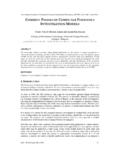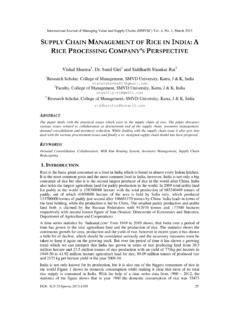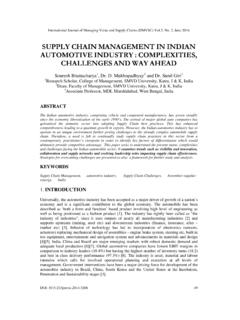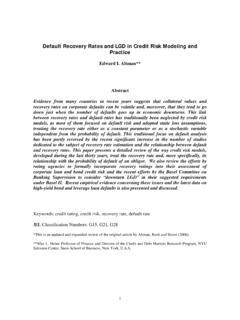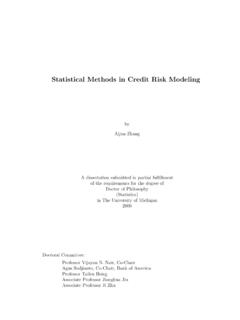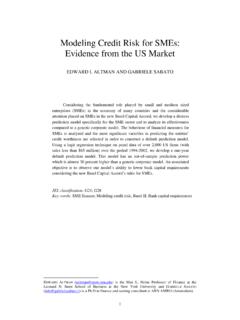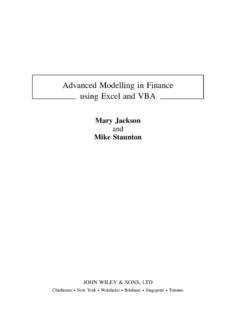Transcription of Business Bankruptcy Prediction Based on Survival …
1 International Journal of Computer Science & Information Technology (IJCSIT) Vol 6, No 2, April 2014 103 Business Bankruptcy Prediction Based on Survival Analysis Approach Ming-Chang Lee National Kaohsiung University of Applied Science, Taiwan ABSTRACT This study sampled companies listed on Taiwan Stock Exchange that examined financial distress between 2003 and 2009. It uses the Survival analysis to find the main indicators which can explain the Business Bankruptcy in Taiwan. This paper uses the Cox Proportional Hazard Model to assess the usefulness of traditional financial ratios and market variables as predictors of the probability of Business failure to a given time. This paper presents empirical results of a study regarding 12 financial ratios as predictors of Business failure in Taiwan.
2 It showed that it does not need many ratios to be able to anticipate potential Business Bankruptcy . The financial distress probability model is constructed using Profitability, Leverage, Efficiency and Valuation ratio variables. In the proposed steps of Business failure Prediction model, it used detail SAS procedure. The study proves that the accuracies of classification of the mode in overall accuracy of classification are KEYWORDS Business Failure Prediction ; Survival Analysis; Cox Proportional Hazard model; Logistic model 1. INTRODUCTION Business Failure Prediction (BFP) models are estimation of the Bankruptcy probability of a firm using a set of covariates, such as financial ratios, Capital turnover, Capital turnover, etc [77]. In past decades, BFP has been a topic research for Business and corporate organizations. Investors or creditors, borrowing organizations and governments are increasing interest to predict of corporate Bankruptcy [26].
3 BFP help to avoid lending to (or investing in) Business likely to fail, early identification of failing Business by regulatory bodies, and more accurate scoring models for rating agencies. Bankruptcy Prediction models use statistical analysis and data mining technique to enhance the decision support tool and improve decision making [68]. Statistical Business failure Prediction models attempt to predict the Business failure or success. The Multiple discriminant analysis (MDA) has been the most popular approaches, but there need a large number of alternative techniques available ([18], [37], [42]). Such as the data mining techniques include decision tree, neural networks (NNs), support vector machine (SVM), fuzzy system, rough set theory, genetic algorithm (GA) [68]. Various researches have demonstrated the artificial intelligence (AI) techniques such as artificial neural networks (ANNs) can serve as a useful tool Bankruptcy Prediction [61].
4 Back propagation neural network (BPNN) was used Bankruptcy Prediction . Before that BPNN some of the techniques followed such as k-nearest neighbor and the tree International Journal of Computer Science & Information Technology (IJCSIT) Vol 6, No 2, April 2014 104 algorithm (ID3) but offered better predictive compare than compared models. Multivariate cumulative sum (CUSUM) is a sequential procedure to predict a Business tendency towards failure. A Survival analysis (SA) technique is the term applied to a dynamic statistical tool used to analysis the time till a certain event [18]. SA uses the Cox proportional hazard model to analysis Survival probability and failure times; it is one dynamic model approach [53]. SA techniques have used to examine the drivers behind the Survival of Internet Business ([29], [30]).
5 Discriminant analysis (DA) and Logit analysis (LA) were found to be slightly superior predictors to the Cox proportional hazard model [27]. Nevertheless, Laitinen and Luoma [33] argued that the SA approach was more natural, flexible, and appropriate and used more information in Business Failure Prediction . Keasey et al. [31] also recommended that SA techniques be used in BFP. Yap et al. [69] use financial ratio and logistic regression for evaluating company failure in Malaysia. The models of enterprise credit risk modes include statistical model, neural network, learning vector, soft-computing, and hybrid models. Table 1 denoted as enterprise credit risk model. Enterprise credit risk evaluation models in this study are Neural networks, Bayesian classifier, Discriminant analysis, Logistic regression, K-nearest neighbor, Decision tree, Case base reasoning, Support vector machine, Software computing, Fuzzy rule- Based system, Generic algorithms, Grey relation, and Hybrid models.
6 Table 1: Enterprise credit risk evaluation models Category Area Some Approach Statistical model Parametric Statistical Method 1. Discriminant analysis 2. Linear multi discriminant analysis 3. Logistic regression 4. Bayesian risk Discriminant analysis Altman [3]; Ohlson [47]; Yap et al. [69]; Stefanescu et al. [56]; Tabachnick and Fidell [59]; Liang and Xin [36] Non-Parametric Statistical Method 1. K- nearest neighbor 2. Cluster analysis Ince, and Aktan [24]; Islam et al. [25]; Lau [34]; Sun and LI [58] Neural Networks Machine learning 1. Multilayer perception 2. Back propagation 3. Radial function neural network 3. Probabilistic neural network 4. Self-organized competition Islam et al. [25; Chen [13]; Lopez [39]; Mues et al. [44]; Sarkar and Sriram [50]; Stefanescu et al. [56]; Tam and Kiang [60] ; Chen [12]; Odom and Sharda [46] Learning vector Machine learning Support Vector Machine Zhou et al.]
7 [72]; Chen et al. [11] ; Kim and Sohin [32]; Shin et al. [52] Soft-computing Reduction attributes 1. Rough sets of reduction knowledge 2. Grey relational of reduction knowledge Dimitras et al. [17]; Cheng et al. [14]; Bian and Mazlack [6]; Hu [23]; Liu et al.[38] ; Tung et al. [62]; International Journal of Computer Science & Information Technology (IJCSIT) Vol 6, No 2, April 2014 105 3. Genetic algorithm of reduction knowledge 4. Fuzzy-Rough Sets Approach Wei et al. [64]; Wong et al. [65]; Zhao [72]; Xinhui and Zhong [67] Survival analysis (SA) Time to event data analysis 1. Credit risk modeling Based on SA 2. Corporate credit risk and the macro economy Stepanova, and Thomas [57]; Antonakis and Sfakianakis [4]; Cao et al. [8]; Sohn et al. [55] Hybrid models Combination of two or more methods 1. Rough - K Nearest Neighbor 2. Rough Sets Neural Network 3. Fuzzy-Rough Sets - Nearest Neighbor 4.
8 Fuzzy- Nearest Neighbor 5. Support Vector Machine with Nearest Neighbor 6. GA- Based neural network approach 7. Ant Colony Algorithm Based on quick-reduct algorithm Tung et al. [62]; Wang et al. [63]; Wei and Zhang[64]; Wong et al. [65]; Xiao et al. [66]; Chaduhuri and De [10]; Tam and Kiang [60]; Yu et al. [70]; Zhang et al. [71]; Zhou and Bai [73]; Zhou et al. [75] The most useful benefits to SA are: (1) In the modeling process, SA is able to take time-varying variables into account [22]. This is done through proportional hazard models [5]. (2) SA is not restricted by the assumption that the distributions of the variables in the data need to be normal [54]. (3) SA only produces positive predictions of time [21]. The time-varying has the potential to not follow a normal distribution. It needs to be positive in predictions and is influenced by time-varying variables.
9 The major contribution of SA methods is estimation procedures that consider changes in the value of covariates over time [35]. Thus, SA approaches to BFP different from the other approaches mentioned above [18]. 3. MERHODOLOGY Logit model In setting up the logistic regression model, first establish the fundamental model for any multiple regression analysis. The outcome variable is assumed as a linear combination of a set of predictors. If outcome variable is Y, and a set of n predictor variables arenXXX,..,,21, the Logit model is: [1] (1) International Journal of Computer Science & Information Technology (IJCSIT) Vol 6, No 2, April 2014 106 Where0 is the expected value of Y whenX s set 0. j is the regression coefficient for each corresponding predictor variablejX. is the error of the Prediction . Defines )(x as the probability that Y = 1.
10 Similarly, 1-)(x is the probability that Y = 0. These probabilities are written in the following form: ),..,,1()(21nXXXYPx ),..,,0()(121nXXXYPx (2) This model for the natural logarithm of the )(1)(xx is: njjjnnXxxXXXYPXXXYP102121)(1)(ln),..,,1( 1),..,,1(ln (3) Using the inverse of the Logit transformation of (3), it obtains at the following: njjXjnjjXjnjjXjneeeXXXYP1)0(101021111),. .,,1( (4) Thus, (4) is a logistic regression model, the conditional mean is between 0 and 1. Now, it will fit the logistic regression model to the data. Firstly, it must establish a technique for estimating the parameters. The maximum likelihood is the method of parameter estimation in logistic regression model.
